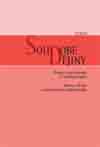Postranní cesty – Schleichwege – drogy boczne – köztes terei. Neoficiální kontakty mezi občany socialistických zemí v letech 1945–1989
Hidden Paths / Postranní cesty / Schleichwege / Drogy boczne / Köztes Terei: Informal Contact between People from Socialist Countries, 1945–89
Author(s): Jaroslav KučeraSubject(s): History
Published by: AV ČR - Akademie věd České republiky - Ústav pro soudobé dějiny
Summary/Abstract: This article, which introduces the first block of essays in the current issue of Soudobé dějiny, presents the international project ‘Hidden Paths/Postranní cesty/Schleichwege/Drogy boczne/Köztes Terei: Informal Contact between People from Socialist Countries, 1945–89. Between a Transnational History of Everyday Life and Cultural Transfer’. The project was carried out in 2006–08 thanks to funding from the Volkswagen Foundation. Its cornerstone was a research group comprising German, Polish, Hungarian, and Czech scholars, and with the collaboration of others. Among these scholars were the authors of the articles in the main thematic block of this issue. The project mainly focused on four central European Communist countries – East Germany, Czechoslovakia, Poland, and Hungary – in which, since the 1960s, tourism began to be intensively developed in connection with state-promoted economic integration, the ideology of socialist internationalism, the expansion of leisure for the whole population, and general trends of civilization. This, however, also opened up space for informal contact and activity. From the point of view of the régimes, these contacts were sometimes problematic or outright ‘subversive’, particularly since the authorities were unable to monitor or regulate them completely. The aim of the project was to consider the various forms of contacts and activities, particularly in the sphere of tourism, illicit or illegal trade, and cultural transfers between the countries of east-central Europe. The results of the project are being published in German, Hungarian, Polish, and Czech.
Journal: Soudobé Dějiny
- Issue Year: XVII/2010
- Issue No: 03
- Page Range: 307-311
- Page Count: 5
- Language: Czech

